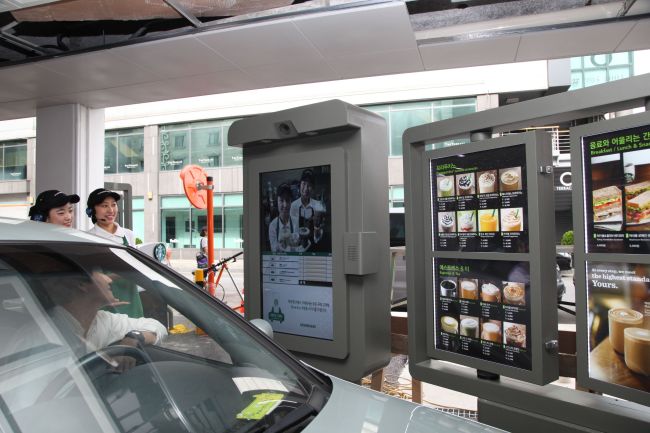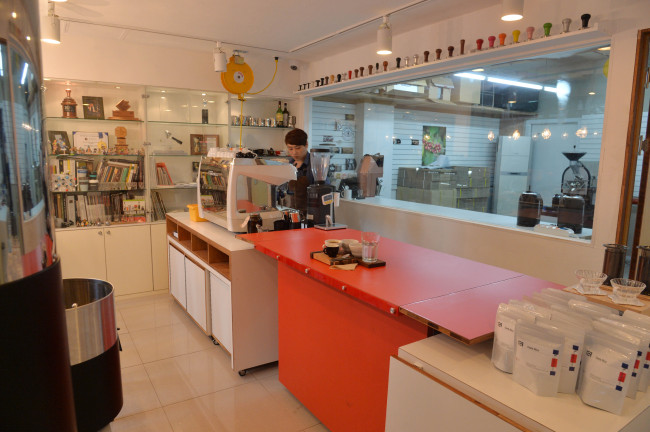
Starbucks, which currently boasts more than 540 stores nationwide, recently opened a second drive-thru spot near Baekseok Station in Gyeonggi Province. (Starbucks Korea)
More than two decades ago, a cup of freshly brewed, whole bean coffee was not so readily available.
Then, Starbucks opened its first Korean store in 1999.
Green bean importer M.I. Coffee’s quality control team executive director Sohng Hyun-geun marks Starbucks’ first landing as the moment when coffee shops started proliferating and a new cafe culture’s golden era started taking root, spurred by “positive interest from trend-sensitive younger generations” and by dramas and films like MBC’s “Coffee Prince.”
That was 14 years ago. Where are Starbucks and the Korean coffee market now?
According to Starbucks Korea public affairs officer Park Han-cho, Starbucks has grown into an over 540-store nationwide chain that sells brews for more than 250,000 customers daily.
Sales of the popular coffee brand-and-chain jumped from 298.2 billion won ($280.1 million) in 2011 to 391 billion won last year.
Furthermore, according to news reports, Korean coffee chain Caffe Bene celebrated the opening of its 1,000th store ― a number which includes its outlets in more than 10 other countries such as China, U.S. and the Philippines ― this August.
The Korean coffee market, as a whole, has also seen notable growth.
According to a weekly briefing released in August by Nonghyup Economic Research Institute, the Korean coffee market more than doubled in size from 2008 to 2012 and the number of coffee shops in Korea is estimated to exceed 15,000 as of last year.
While coffee spending saw its first drop this year since 2007, according to financial investment industry statistics, the verdict is not yet out on how this first-quarter decrease will affect the coffee market this year.
Starbucks Korea’s Park, for one, retains a positive outlook.
“We predict over double-digit growth this year as well,” said Park, 36.
Amid all this expansion and growth, the Korean coffee market has also seen its fair share of coffee trends. One particular trend that seems to be on the rise is domestically roasted, specialty coffee.
What is specialty coffee?
According to Coffee Libre owner-roaster Seu Pil-hoon, it is coffee that nabs points of 80 or more from the Specialty Coffee Association of America and the Alliance for Coffee Excellence.
Given the high bar set for specialty coffee, it should come as no surprise when Coffee Graffiti CEO Lee Jong-hoon stresses that those highly rated beans with a provenance form a small slice of the international brew pie.
Despite the price tag that may come with relatively harder-to-come-by specialty coffee, this premium coffee seems to be attracting more followers. One can now find more professional roasters dedicated to producing expertly roasted, upscale brews here.
“Worldwide demand for high-quality green coffee is on the rise, and many roaster-cafes that professionally handle these premium-grade green beans have appeared in Korea as well,” Sohng, 34, explained. “Roaster-cafes that put the focus on coffee’s star ingredient, the green bean, have popped up rapidly.”
As a result, M.I. Coffee ― which sells to large companies as well as small, independent roasters ― has also seen a trend toward rapidly rising demand for its own imports of specialty green coffee.
Coffee Libre, which roasts specialty coffee, has also seen a jump in business this year.
Coffee Libre owner-roaster and green bean buyer Seu, one of the nation’s first licensed Q-Graders, still remembers when he could barely call his business a roaster.
“We were doing more educational work than roasting,” he recalled from when Coffee Libre first opened its roasting headquarters in Seoul’s Yeonnam-dong four years ago.
Now, roasting orders for Coffee Libre’s specialty coffee have jumped 10-fold and the roaster’s monthly subscription program, where a weekly selection of quality beans is sent to customers, boasts around 300 subscribers.
Coffee Libre also recently opened two cafes in Seoul, one last summer in Yeonnam-dong and the other three months ago in Hannam-dong.
“I do feel that there is a gradual increase in people who are taking an interest in coffee, and that that interest is starting to escalate more rapidly,” said Seu, 37, who takes great pride in traveling out to each coffee farm he trades with every year and roasting beans in Coffee Libre’s new Gyeonggi Province-based atelier.
“I call it coffee with a face,” said Seu. “When I roast my coffee, I am immediately able to remember the farmer who harvested it.”

Coffee Graffiti, a specialty coffee roaster near Hapjeong Station, invites visitors to come in for tastings of rare varietals like Panama’s Geisha and custom-tailored blends and beans roasted on the premises. (Lee Sang-sub/The Korea Herald)
Coffee Graffiti, which opened this January near Hapjeong Station in Seoul, is one of the latest specialty coffee roasters to join a growing pack.
Beans roasted by Coffee Graffiti can be tasted on the premises, including highly coveted varietals like Panama’s Geisha, which boasts a growing international following that simply cannot get enough of the aromatic, award-toting brew.
One sip of Coffee Graffiti’s roasted Geisha sheds light on the charms of specialty coffee.
Initial rich chocolate tones are immediately followed by the sour, mouth-puckering citrus of lemon before being upended once again by a delicate floral nose of orchids and gardenias. Then, a long, lingering note of honey sweetens the deal.
Like Coffee Libre, which first started out as a roaster, Graffiti’s focus is on roasting specialty coffee.
Though one might mistake the business’ tasting room for a cafe, it is actually a place where visitors can sit down and experience a complimentary tasting (most guests toss in a 2,000 won tip) and if so desired, purchase custom-tailored blends roasted on the premises for around 7,000 won to 10,000 won.
“I like to call it coffee styling,” said Coffee Graffiti barista-manager Park Seung-kyu.
According to Park, Coffee Graffiti currently sports a steady client base of around 30, most of whom run their own small cafes and shops, in addition to individual customers who come for custom, on-the-premises roasts.
“I think standards are very high now,” said Park, 27, predicting a bright future for artisanal roasters. “Koreans definitely know what adds up to a good cup of coffee.”
Large businesses seem to also be taking note.
In April, cafe-bakery chain Artisee launched a coffee project.
“We selected artisans who displayed a professional knowledge of coffee and approached coffee roasting with their own particular coffee philosophy,” an Artisee marketing team representative said.
Both Coffee Libre and Coffee Graffiti took part in the project, which gave Artisee customers the opportunity to taste both roasters’ brews.
Artisee also launched a temporary pop-up store this month featuring various artisanal roasters in Seoul’s Garosugil.
And the chain says there is even more in store.
“This is an ongoing project,” the representative said.
“I was very surprised,” Coffee Graffiti’s Lee, 29, said of the Artisee Coffee Project. “Having a huge company join hands with a private roaster meant that the market itself was interested in us roasters.”
According to Lee, there is a limit, however, to how much the market for domestically roasted, artisanal specialty coffee can expand, given its relative rarity.
That does not mean there is no room for growth.
In fact, M.I. Coffee’s Sohng predicts a continued expansion of the premium coffee market, including the specialty coffee sector.
“These days it is on trend for the media outlets to address improvements in coffee quality, which in turn raises consumer awareness of quality coffee.”
By Jean Oh (oh_jean@heraldcorp.com)







